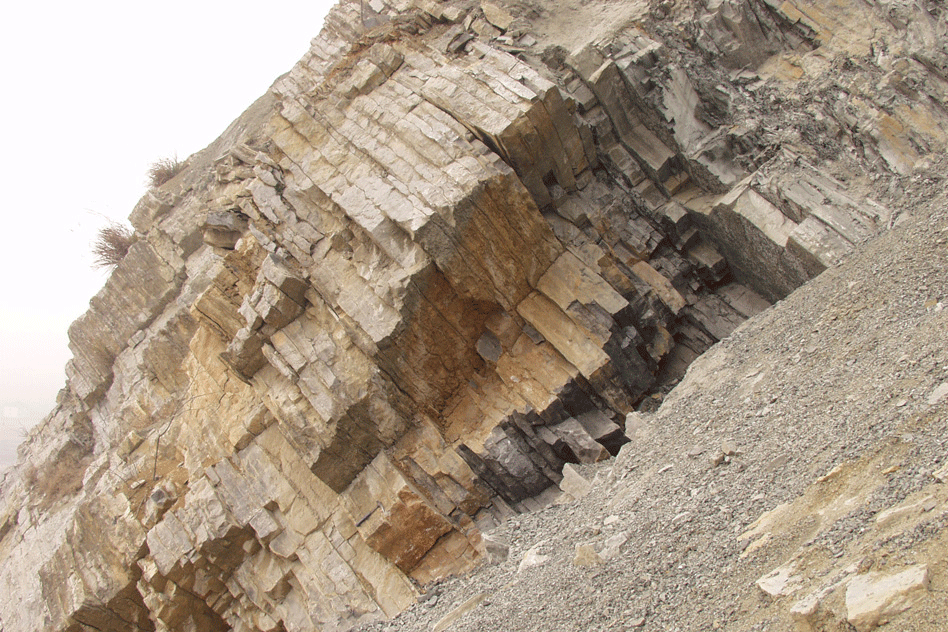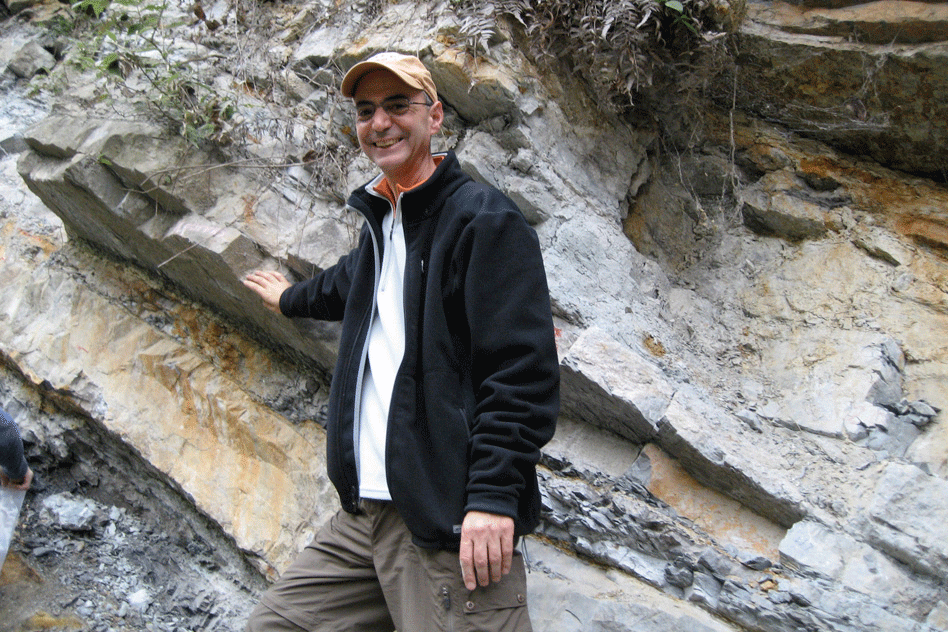The Growing Threat From Methane
Air Date: Week of April 11, 2014

A photo of the permian triassic boundary at Meishan, China. This photo shows the limestone beds in between the volcanic ash beds that the researchers were able to date. (Shuzhong Shen)
Over the short term, methane is 80 times more powerful as a greenhouse gas than carbon dioxide. The White House has launched plans to control methane emissions from most US sources, but as Living on Earth's Helen Palmer reports, evidence from prehistory suggests methane was a major factor in Earth's largest extinction, and warming projections warn of ballooning emissions in the future.
Transcript
CURWOOD: Every so often, a cluster of stories come along around the same time that make you think there must be something in the air, or maybe the water. Well that's been happening recently, and indeed there IS something in the air - and in the water - and it’s the powerful greenhouse gas, methane. Living on Earth's Helen Palmer has the story.
PALMER: There's more than twice as much methane in the atmosphere now as there was before the Industrial revolution. That's thanks to our energy generation, agriculture, and the stuff we throw away. And there's reason we should care - methane's an extremely powerful greenhouse gas.
OBEITER: Over a 20 year period it's over 80 times as strong as CO2 over 100 years. The number's about 34 according to the most recent estimates.
PALMER: That's Michael Obeiter, the methane expert at the World Resources Institute. So he welcomes the latest announcement from the White House's Climate Action Plan, new rules to control methane.

MIT professor of geophysics Daniel Rothman stands next to part of the Xiakou formation in China. His right hand rests on the layer that marks the time of the end-Permian mass extinction event, showing large amounts of nickel spewed from volcanic activity at this time, 252 million years ago. (Daniel Rothman)
OBEITER: It's got a four-pronged approach, looking at methane emissions from various sectors. It's going to address emission from landfills, coalmines, agriculture and oil and gas development which are four of the largest sources of methane emissions in the US.
PALMER: Obeiter says some of the steps the White House laid out have a lot going for them. Take the plans for oil and gas production, for example.
OBEITER: The Administration is planning to look at ways to reduce leaks and vents of methane from oil and gas development on public lands. This is an excellent strategy, but it's also among the lowest hanging fruit. Methane is the primary component of natural gas, and so capturing methane allows producers to sell more gas to market.

Michael Obeiter, Senior Associate at World Resources Institute. (World Resources Institute)
PALMER: It's tougher to control methane that escapes from decaying organic garbage, but tapping gas from landfills can generate energy, and that’s what the tech firm Apple is doing. The EPA plans to release updated landfill standards this summer along with voluntary measures to help dairy farmers install methane-digesters, to generate power from manure. And talk of methane digesters brings us to a second piece of news: MIT research that fingers methane-creating microbes as perhaps a major player in what's called the end-Permian extinction. Lead author, MIT Geophysicist Daniel Rothman.
ROTHMAN: It's the biggest extinction in the last 540 million years, which is the length of time over which we have a good understanding of the geologic record.
PALMER: It was about 252 million years ago and about 90 percent of all species on earth were wiped out. Massive volcanoes covered Siberia with some 240,000 cubic miles of magma, and launched 10,000 gigatonnes of carbon dioxide into the atmosphere. But Rothman says after that the arithmetic on the amount of carbon just didn't add up - carbon levels kept going up and up and up over time.
ROTHMAN: We hypothesized that the cause could have been microbial in origin. There are reasons to believe, geochemical reasons to believe, that there was a stockpile of detritus in the oceans and we asked ourselves, “What if a microbe evolved a new ability to consume that detritus?”
PALMER: They went looking for such a microbe, and found an archaeon, an ancient microbial species called Methanosarcina that about this time underwent an evolutionary change so it could more efficiently chew up organic matter and produce methane.
ROTHMAN: So we therefore found a culprit if you wish, having hypothesized that a microbe could have done it. We then identified a microbe, Methanosarcina. So that led to a date.
PALMER: And that date is 240 million years ago, plus or minus 40 million years, which conveniently includes the end-Permian extinction. Rothman says there's further evidence - methane producing microbe needs nickel, and the massive volcanic eruptions created huge nickel deposits found in sediments, allowing the Methanosarcina to flourish. The methane they created reacted with seawater to create CO2, which acidified the oceans, explaining another mystery of this extinction.
ROTHMAN: Researchers before us had noted that animals with heavily calcified shells preferentially went extinct and that had led them to conclude that the kill mechanism, as they worded it, was ocean acidification. So what we're doing is providing a mechanism for the ocean acidification.
PALMER: Given current concerns about increasingly acidified oceans, this research from pre-history sounds a warning note for the future. And so does some more research just published in the journal Nature. It examined methane locked up in decomposing organic matter in water sources such as ponds and wetlands. In 2011, Iowa State Ecology professor John Downing told Living on Earth just how much methane is locked up in small ponds and the like.

Schematic of the global methane cycle. Numbers represent annual fluxes in Tg(CH4) yr–1 estimated for the time period 2000–2009 and methane reservoirs in Tg (CH4).
(IPCC report 2013)
DOWNING: Well, it’s kind of hard to wrap your head around the numbers, because they’re usually measured in things like petagrams which is kind of an immense amount of material. But it’s equivalent to about 25 percent of all of the carbon that’s taken up and sequestered by terrestrial environments worldwide.
PALMER: As Professor Downing says, that methane's locked up there, but the new Nature paper examines what's likely happen as these ponds and rice paddies heat up. Analysis of 1,600 measurements across the globe shows that as the temperature rises, more methane escapes. For instance, a rise from zero to 30 degrees Celsius would create emissions as much as 57 times higher. That's an extreme temperature rise, but possible between winter and a summer heat wave. All biological rates tend to double with each ten degrees of warming. As MIT's Daniel Rothman puts it...
ROTHMAN: This is a very good example of positive feedback in which as the climate warms the permafrost will melt, previously frozen organic matter will be then metabolized by methanogens or other micro-organisms which will produce more greenhouse gases which will then produce more warming which will speed up rates even more.
PALMER: Which means that the warnings of both the methane burp associated with the Permian extinction, and projections for accelerating methane emissions as ponds and wetlands warm, make attempts by the White House to control this potent greenhouse gas escaping to the atmosphere not only prudent but vital. Michael Obeiter of the World Resources Institute, again.
OBEITER: The next 20 years will be crucial in ensuring that globally greenhouse gases peak within the next ten years or so and then start declining pretty significantly if we're going to avoid the worst impacts of climate change.
PALMER: At the moment, he says, time is not on our side. For Living on Earth, I'm Helen Palmer.
Links
White House Methane control plans
World resources institute Comment on the White House plans
A Close Look at Fugitive Methane Emissions from Natural Gas
Capturing the Fugitives: Reducing Methane Emissions from Natural Gas
5 Reasons Why It's (Still) Important to Reduce Fugitive Methane Emissions
Methane fluxes show consistent temperature dependence across microbial to ecosystem scales
Freshwater Methane Emissions Offset the Continental Carbon Sink
Carbon and Other Biogeochemical Cycles - Climate Change 2013 ...
Methanogenic burst in the end-Permian carbon cycle
3 Ways the US and China Can Work Together for Responsible Shale Gas Development
Living on Earth wants to hear from you!
Living on Earth
62 Calef Highway, Suite 212
Lee, NH 03861
Telephone: 617-287-4121
E-mail: comments@loe.org
Newsletter [Click here]
Donate to Living on Earth!
Living on Earth is an independent media program and relies entirely on contributions from listeners and institutions supporting public service. Please donate now to preserve an independent environmental voice.
NewsletterLiving on Earth offers a weekly delivery of the show's rundown to your mailbox. Sign up for our newsletter today!
 Sailors For The Sea: Be the change you want to sea.
Sailors For The Sea: Be the change you want to sea.
 The Grantham Foundation for the Protection of the Environment: Committed to protecting and improving the health of the global environment.
The Grantham Foundation for the Protection of the Environment: Committed to protecting and improving the health of the global environment.
 Contribute to Living on Earth and receive, as our gift to you, an archival print of one of Mark Seth Lender's extraordinary wildlife photographs. Follow the link to see Mark's current collection of photographs.
Contribute to Living on Earth and receive, as our gift to you, an archival print of one of Mark Seth Lender's extraordinary wildlife photographs. Follow the link to see Mark's current collection of photographs.
 Buy a signed copy of Mark Seth Lender's book Smeagull the Seagull & support Living on Earth
Buy a signed copy of Mark Seth Lender's book Smeagull the Seagull & support Living on Earth

